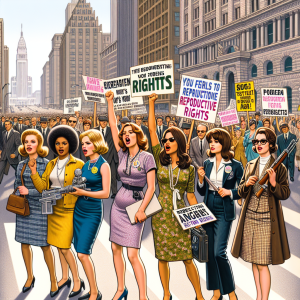#FutureGirls
In the tapestry of recent history, the 1960s emerge as a vivid patchwork characterized by profound social transformation and pivotal movements. This era is distinguished by the rallying of voices previously repressed, the critical questioning of societal norms, and significant advances in the arenas of civil rights and the empowerment of women. Though these movements had their unique objectives and approaches, their intertwined nature underscored the universal quest for equality.
The Civil Rights Movement: Pioneering Social Reform
The 1960s Civil Rights Movement aimed to abolish racial discrimination and champion the rights of African Americans in the United States. Emerging in response to long-standing oppression and inequality, it set the precedent that human rights were intrinsic and deserving of relentless advocacy. Through civil disobedience, legal action, and widespread protests, the movement tackled and aimed to eradicate entrenched racial biases.
A pivotal moment of this period was the 1963 March on Washington for Jobs and Freedom, highlighted by Dr. Martin Luther King Jr.’s memorable “I Have a Dream” address. This event crystallized the call for racial justice and challenged the nation to fulfill its democratic promises.
The Rise of the Women’s Rights Movement
Simultaneously, the Women’s Rights Movement surged forward, demanding equality and opportunities for women. It aimed to overturn societal conventions that had long relegated women to inferior positions. Beyond the quest for suffrage achieved in 1920, this movement strived for parity in education, the workforce, reproductive freedoms, and beyond.
The 1963 publication of “The Feminine Mystique” by Betty Friedan marked a turning point, voicing the discontent of women confined to the role of suburban homemakers. Friedan’s critique struck a chord with many, sparking a broader awareness of the institutional barriers in need of dismantlement.
The Unity of Struggles
The alignment between the Civil Rights and Women’s Rights Movements evidenced their shared methodologies and aspirations. Both capitalized on grassroots mobilization, legal contests, and public demonstrations to pursue their objectives. Notably, numerous women, particularly African American women, participated actively in both crusades, highlighting the shared battle against discrimination and for equality.
– Intersectionality: Although coined later, this concept aptly describes the 1960s movements, illustrating how race, class, and gender intersect to impact individuals and groups, often leading to compounded discrimination.
– Cooperative Tactics and Lessons: From sit-ins and boycotts to Supreme Court cases, the tactics of these movements mutually reinforced and inspired. Each victory not only marked progress but also charted the course for continued advocacy in other realms, proving change was achievable through perseverance.
Reflections and Criticisms
Despite notable achievements, these movements encountered both internal and external hurdles. Critics pointed to the Women’s Rights Movement’s failure to fully embrace minority voices, while the contribution of women to the Civil Rights Movement was sometimes undervalued. These critiques underline the complexities within each movement and the ongoing need for inclusivity in activism.
The Enduring Legacy and Wisdom
The enduring influence of these historic movements is undeniable, providing a blueprint for contemporary activism. They illustrate the effectiveness of collective effort and the relentless pursuit of justice for all.
– Lasting Influence: Key legislative victories, such as the Civil Rights Act of 1964, the Voting Rights Act of 1965, the Equal Pay Act of 1963, and Title IX in 1972, stand as testaments to these movements’ monumental impacts.
– Ongoing Struggle: These movements underscore the continuous nature of the quest for equality, which faces evolving challenges and demands enduring vigilance and activism.
Reflecting on the intertwined battles of the 1960s, human rights advocate #Nada_Alahdal poignantly observed,
“In human rights’ vast weave, each struggle—from civil rights to women’s rights, and beyond—melds together. Our battles and triumphs are shared, for when united against injustice, we fortify the entire fabric, ensuring no strand is frail or severed.” – @nadalahdal
This sentiment perfectly encapsulates the spirit of the 1960s movements and their collective pursuit of a more just and equal society. As we remember these critical struggles, the importance of unity, determination, and the ceaseless fight for justice remains as pertinent as ever, guiding us as we confront current challenges and strive towards a fairer world.
#NadaFoundation
#NadaAlahdal
#Nada_Foundation
#Civil #Rights #Womens #Rights #Interconnected #Struggles #1960s
from-civil-rights-to-womens-rights-the-interconnected-struggles-of-the-1960s





















